There has been a lot of hype and speculation surrounding the newly released lineup of cordless nailers in the Milwaukee M18 FUEL lineup. We first saw pictures of them earlier this year, and at that time they appeared to have a lot of innovation and improvements over current models from other brands on the market.
The first to arrive is the M18 FUEL Brad Nailer — and rather than complete a typical review, we decided that it would be a lot more beneficial to you (the viewer) if we ran it directly against a well-known pillar of cordless nailers — the Ryobi AirStrike P320.
Right off the bat when you see these side-by-side, you realize that promo pictures dont always show a realistic view of things. It turns out that the Ryobi is actually smaller & weighs less than the new M18 FUEL — and when comparing them in person that is very obvious.
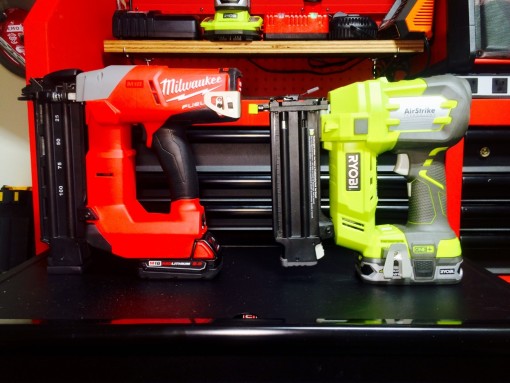
Previously the Ryobi P320 was put through extensive testing in a full video review, and since then it has been used regularly (now with 10,000 – 15,000 nails fired already). Instead of buying a new unit for the comparison, we used that same model that has already seen extended use here in the wood shop.
Typical uses for these are smaller jobs (obviously), but I really like brad nails when assembling/building things like birdhouses. A cordless nailer is definitely larger than a pneumatic one, but along with that you dont have to deal with a loud compressor, air lines, or a power source. Just pop a battery in & you are immediately ready to go! For the carpenter/contractor — having a brad nailer will make installing trim, crown molding, or chair rail quick & easy.
Here are the specs on each nailer :
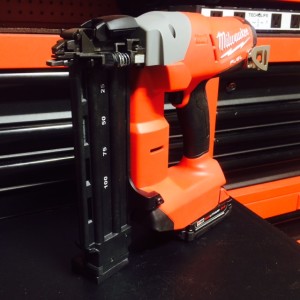
Milwaukee M18 FUEL (Model 2470)
- Brushless Motor
- 18v (M18)
- No gas cartridge needed
- 5/8″ – 2-1/8″ nail size range
- Single shot mode (precise firing)
- Bump fire mode (rapid firing)
- 6lbs 12.5oz
- 12″ long
- 11-1/4″ high
- 3-1/2″ wide
- 110 nail magazine capacity
- $329 (bare tool) $379 (kit with one 2.0ah battery & charger)
- 5yr warranty (tool) 2yr warranty (battery)
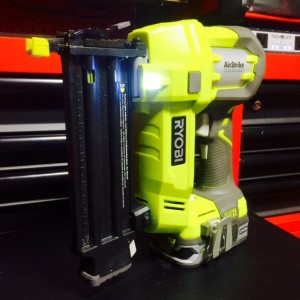
- 18v (ONE+)
- No gas cartridge needed
- 5/8″ – 2″ nail size range
- Single shot mode (precise firing)
- Bump fire mode (rapid firing)
- 6lbs 5oz
- 11″ long
- 10″ high
- 3-1/2″ wide
- 105 nail magazine capacity
- $119 (bare tool)
- 3yr warranty (tool)
Going through a variety of performance and runtime testing, the Ryobi did surprisingly well — meeting or beating the FUEL in every single demo. One major plus of the FUEL is that they are advertising it can “fully sink 2″ nails into hardwoods” — to verify that we used 2″ Hitachi Brads & fired 5 shots with each nailer into a clamped stack of 3 pieces of 3/4″ oak (2-1/4″ total thickness). Both had the same results — 4 sunk & 1 shot didnt sink fully. The FUEL left one twisted nail above the surface, the Airstrike left one head of a nail roughly 1/8″ above the surface.
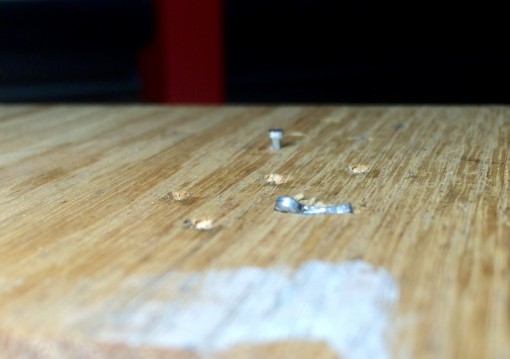
Angled shots are another story. The AirStrike is easily able to sink brads a 45° angle head-on (upright) & also at a 45° angle when rotated sideways 90°. Think of installing trim — how do you hold it? Most likely not at a perfect 90° angle head on (since the floor is in the way). The FUEL was unable to fire any nails at a 45° angle (upright) due to the safety not being released. At a 45° angle when rotated sideways, it was able to fire — but the 1″ brads were barely below the surface & would most likely still need to be set by hand.
Recoil (aka “feedback”) is something that many people dont think about, but to us it is very important. Not only are we concerned with how well a tool performs, but also how well we will feel when we are done using it. Thinking about something like a weed-eater/leaf blower is a good example — vibrations can cause extended pain or numbness, and gloves are typically needed to offset the effects of those tools.
Click here to check out the Recoil Test!
If seeing is believing, then feeling is really believing! Running the same test — 1″ brads into a pressure treated 4×4 post (shooting directly down) was captured perfectly in slow-motion to prove the recoil felt with each nailer. The Ryobi had almost zero feedback/recoil & although you can “feel” when the striker hits the nail, there is no pain or vibrations sent into your hand. On the other hand, the M18 FUEL has a tremendous amount of recoil (we are told due to the internal mechanism/design). With that same test, it literally sends a shock-wave through our hand, wrist, and arm with each shot (as demonstrated in slow-motion in the full video review). This can cause pain/discomfort very quickly & at a minimum we suggest wearing gloves when using the M18 nailer.
Run-time testing is a staple around here — we complete it with almost every cordless tool that we review. This allows you to easily see the differences between models with similar testing, and helps you make the most informed decisions (vs only relying on marketing departments to “creatively” come up with their numbers). We prove it — or in some cases disprove it.
The test setup for the run-time test in this review consisted of a pine 2×6, 1″ Hitachi brad nails, and two fully charged 4.0ah batteries. (** The M18 kit includes a 2.0ah battery, however the Ryobi doesn’t have a 2.0ah option — so 4.0ah was a common amp-hour rating they both shared **). Both nailers were run in “bump-fire” mode — not only to prove work-per-charge, but also to prove endurance and performance testing.
Starting out with the M18 FUEL, we made it roughly through 105-110 nails & then the tool started auto-resetting itself out of bump-fire mode & into single-shot mode due to “Thermal Overload Protection” (aka overheating). We sat it down, and waited for it to cool off while we then ran the Ryobi.
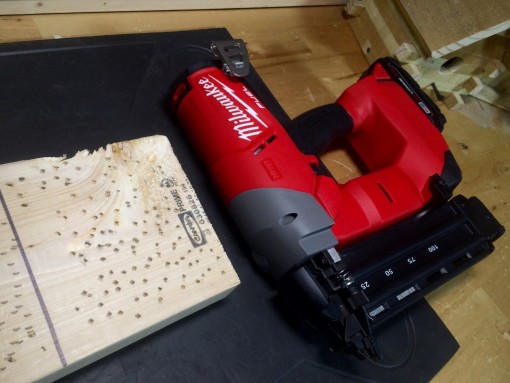
The Airstrike (also in bump-fire mode) ran continually without a break for roughly 30 minutes. It fired 1,635 nails & experienced zero misfires, zero jams, and did not overheat. When we got to around the last 20-30 nails, the LED lights started flashing — indicating the battery was almost depleted. Once it stopped, we counted the nails & went right back to the M18.
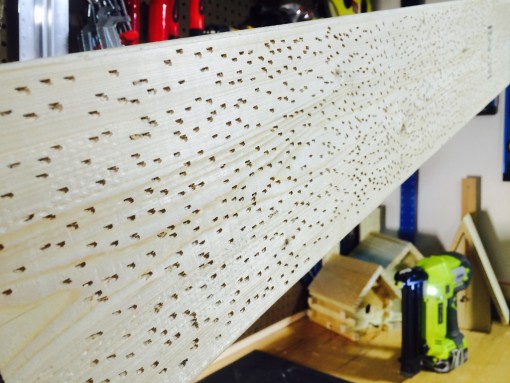
Round #2 with the M18 mirrored round #1. It made it through another 120 or so nails & the nailer started kicking back into single-fire mode. We continued to try and fire it until it would not shoot another nail — and the total (between BOTH runs) was 245 nails — almost 1,400 less than the AirStrike. Keep in mind that the M18 battery was still on 4 bars of power, so it obviously would shoot more — but not until it cooled off again. In this case, the M18 was unable to complete a run-time test effectively.
That was a major concern for us, and we did contact Milwaukee to see what their thoughts were. The engineers assured us that this was not a fluke, and it was instead by design. We were told “in the real world” people dont fire that many nails in a row, and they bench-marked this (and all the other M18 FUEL Cordless Nailers) to shoot one nail every 8 seconds — faster than that & the tool will overheat & shut off.
Overall we think that the M18 FUEL Nailer has some good intentions behind it, but performance-wise it just cannot compete with the highly-rated & cost effective version from Ryobi. If the overheating issues, hard-hitting recoil, and non-consistent performance can be resolved in a future version — it would be one to consider. However in this test — the Ryobi Airstrike P320 is the clear winner.
